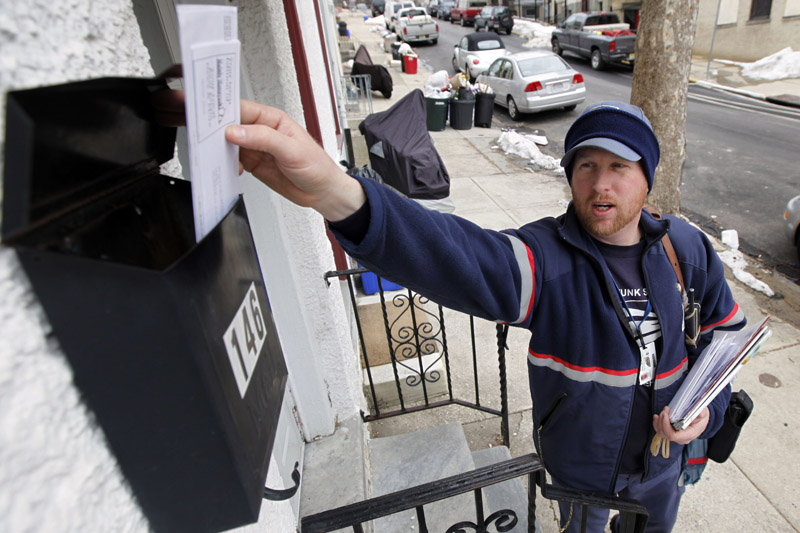WASHINGTON — The post office is renewing its effort to drop Saturday delivery – and plans a rate increase – in an effort to fend off a projected $7 billion loss this year.
Without drastic action the agency could face a cumulative loss of $238 billion over 10 years, Postmaster General John Potter said in releasing a series of consultant reports on agency operations and its outlook.
“The projections going forward are not bright,” Potter told reporters in advance of today’s announcement. But, he added, “all is not lost … we can right this ship.”
As Americans turn more and more from paper to electronic communications, the number of items handled by the post office fell from 213 billion in 2006 to 177 billion last year. Volume is expected to shrink to 150 billion by 2020.
At the same time, the type of material sent is shifting from first-class mail to the less lucrative standard mail, such as advertising, Potter pointed out.
And as people set up new homes and businesses, the number of places mail must be delivered is constantly increasing.
The agency has asked Congress for permission to reduce delivery days and has previously discussed the need for other changes such as closing some offices.
Cutting back Saturday home delivery, however, does not mean post offices would close that day.
There seemed to be concern on the part of Congress that officials had not looked at all possible options, Potter said, adding that was part of the reason for the three consultant studies.
Potter said he would like to see mail delivery cut to five-days-a-week starting next year.
Later this month, he said, the Postal Service will ask the independent Postal Regulatory Commission to review its plans for the service reduction.
Under the law, the agency is not supposed to raise rates more than the amount of inflation, but there is a loophole allowing for higher increases in extraordinary situations such as the current recession and drop in mail volume.
“We intend to use that tool,” Potter said.
He said the USPS’s governing board is engaged in lively discussions of rate increases, though he declined to speculate on a new price.
Currently, first-class stamps cost 44 cents. Rates for other classes vary.
“We need to walk slowly and very, very careful” in raising prices, Potter said, noting that increases can also drive business away.
A proposal before the Postal Regulatory Commission has estimated that increases of 3 percent this year and 10 percent next year would be needed to get the agency back to break-even.
While suggestions to close local post offices always draw complaints, Potter said the current system could be improved by opening more postal facilities in places like convenience stores and supermarkets. A few Office Depot stores are already doing this, he said.
The average post office has 600 patrons -week, Potter said, while the average supermarket brings in 20,000 people each week and is open longer hours and more days.
Only after such new facilities were available would a local post office close, he said.
Moneysaving ideas considered and dismissed by the consultants included reducing the efficiency of mail delivery, Potter said.
Currently, the standard is to deliver first-class mail in one-to-three days, depending on the distance traveled. Reducing this to two-to-five days could save money by allowing more use of ground transport, but Potter said it would also reduce the value of mail use, especially to businesses.
Another possibility would be to ask Congress for a subsidy, but noting the current financial conditions Potter said “we do not plan to pursue that.” The post office has not received taxpayer subsidies for its operations since the early 1980s.
Potter said the agency is looking to new types of mail services to offer but will not seek to get into other types of business, such as banking, which are offered by many foreign postal services.
The agency has cut its work force from a peak of 800,000 career employees to currently about 600,000, and Potter said it wants to use more part-time people in the future. Over the next 10 years some 300,000 postal workers will become eligible to retire and that will offer an opportunity to make this change, he said.
A major problem for the agency is a new requirement for an annual payment of $5.5 billion to prepay expected medical benefits for retirees. Most businesses handle that cost on a pay-as-you-go basis and Potter said he is seeking congressional approval for the post office to go back to that standard.
Send questions/comments to the editors.



Success. Please wait for the page to reload. If the page does not reload within 5 seconds, please refresh the page.
Enter your email and password to access comments.
Hi, to comment on stories you must . This profile is in addition to your subscription and website login.
Already have a commenting profile? .
Invalid username/password.
Please check your email to confirm and complete your registration.
Only subscribers are eligible to post comments. Please subscribe or login first for digital access. Here’s why.
Use the form below to reset your password. When you've submitted your account email, we will send an email with a reset code.